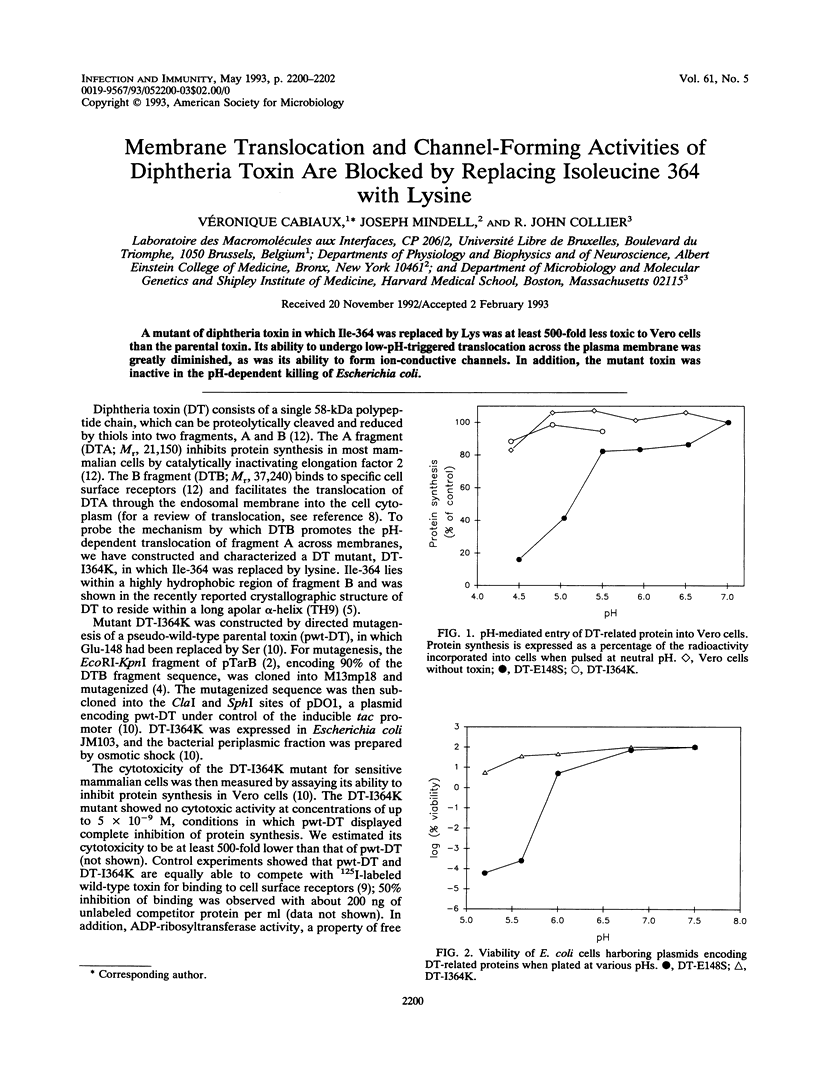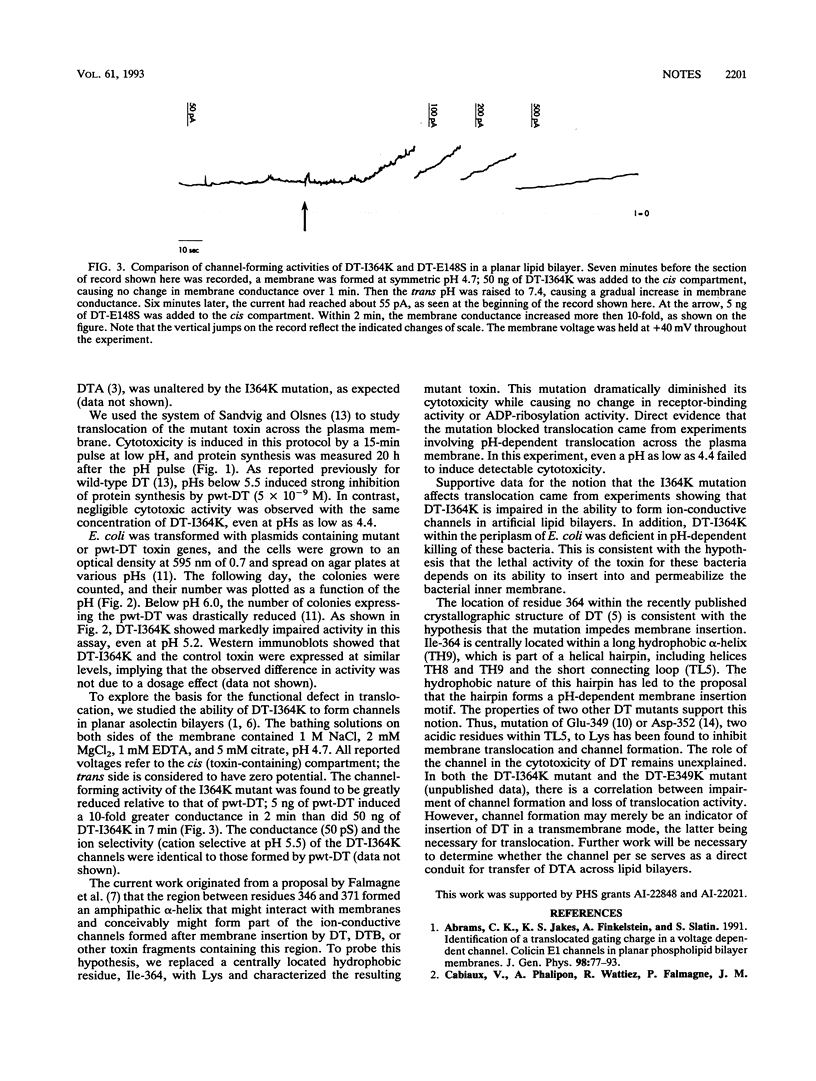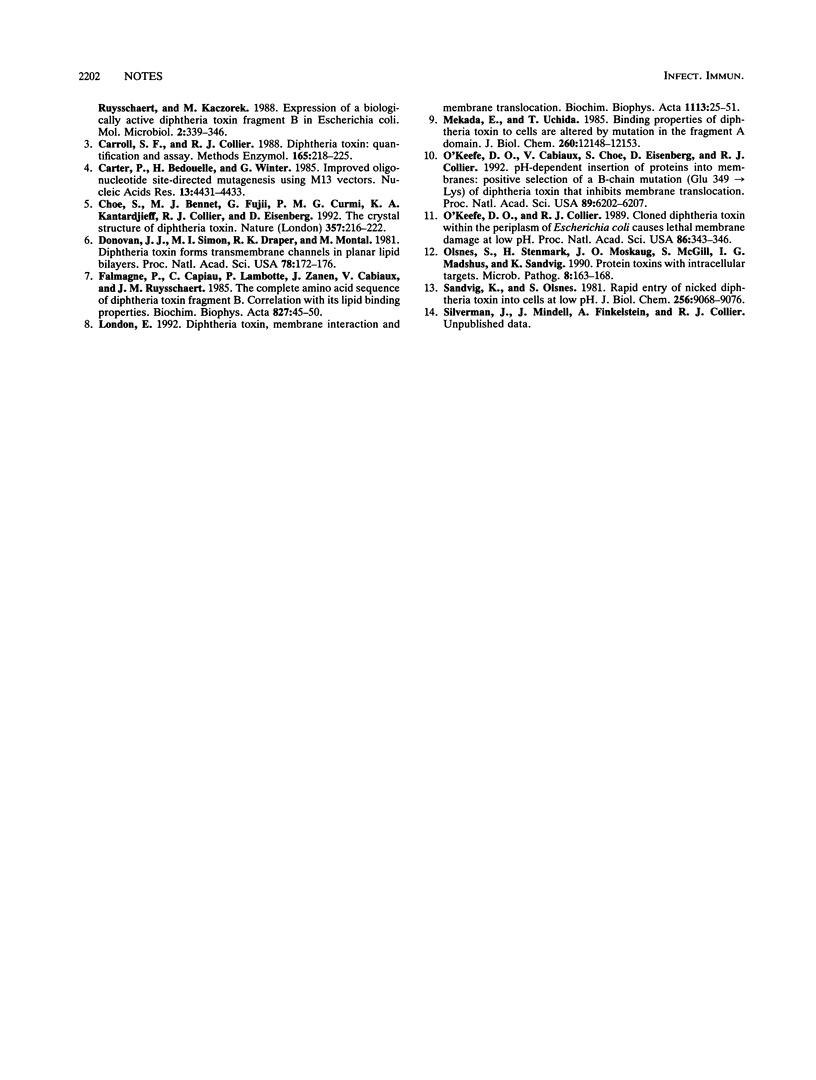Abstract
A mutant of diphtheria toxin in which Ile-364 was replaced by Lys was at least 500-fold less toxic to Vero cells than the parental toxin. Its ability to undergo low-pH-triggered translocation across the plasma membrane was greatly diminished, as was its ability to form ion-conductive channels. In addition, the mutant toxin was inactive in the pH-dependent killing of Escherichia coli.
Full text
PDF


Selected References
These references are in PubMed. This may not be the complete list of references from this article.
- Abrams C. K., Jakes K. S., Finkelstein A., Slatin S. L. Identification of a translocated gating charge in a voltage-dependent channel. Colicin E1 channels in planar phospholipid bilayer membranes. J Gen Physiol. 1991 Jul;98(1):77–93. doi: 10.1085/jgp.98.1.77. [DOI] [PMC free article] [PubMed] [Google Scholar]
- Cabiaux V., Phalipon A., Wattiez R., Falmagne P., Ruysschaert J. M., Kaczorek M. Expression of a biologically active diphtheria toxin fragment B in Escherichia coli. Mol Microbiol. 1988 May;2(3):339–346. doi: 10.1111/j.1365-2958.1988.tb00037.x. [DOI] [PubMed] [Google Scholar]
- Carroll S. F., Collier R. J. Diphtheria toxin: quantification and assay. Methods Enzymol. 1988;165:218–225. doi: 10.1016/s0076-6879(88)65034-8. [DOI] [PubMed] [Google Scholar]
- Carter P., Bedouelle H., Winter G. Improved oligonucleotide site-directed mutagenesis using M13 vectors. Nucleic Acids Res. 1985 Jun 25;13(12):4431–4443. doi: 10.1093/nar/13.12.4431. [DOI] [PMC free article] [PubMed] [Google Scholar]
- Choe S., Bennett M. J., Fujii G., Curmi P. M., Kantardjieff K. A., Collier R. J., Eisenberg D. The crystal structure of diphtheria toxin. Nature. 1992 May 21;357(6375):216–222. doi: 10.1038/357216a0. [DOI] [PubMed] [Google Scholar]
- Donovan J. J., Simon M. I., Draper R. K., Montal M. Diphtheria toxin forms transmembrane channels in planar lipid bilayers. Proc Natl Acad Sci U S A. 1981 Jan;78(1):172–176. doi: 10.1073/pnas.78.1.172. [DOI] [PMC free article] [PubMed] [Google Scholar]
- Falmagne P., Capiau C., Lambotte P., Zanen J., Cabiaux V., Ruysschaert J. M. The complete amino acid sequence of diphtheria toxin fragment B. Correlation with its lipid-binding properties. Biochim Biophys Acta. 1985 Jan 21;827(1):45–50. doi: 10.1016/0167-4838(85)90099-8. [DOI] [PubMed] [Google Scholar]
- London E. Diphtheria toxin: membrane interaction and membrane translocation. Biochim Biophys Acta. 1992 Mar 26;1113(1):25–51. doi: 10.1016/0304-4157(92)90033-7. [DOI] [PubMed] [Google Scholar]
- Mekada E., Uchida T. Binding properties of diphtheria toxin to cells are altered by mutation in the fragment A domain. J Biol Chem. 1985 Oct 5;260(22):12148–12153. [PubMed] [Google Scholar]
- O'Keefe D. O., Cabiaux V., Choe S., Eisenberg D., Collier R. J. pH-dependent insertion of proteins into membranes: B-chain mutation of diphtheria toxin that inhibits membrane translocation, Glu-349----Lys. Proc Natl Acad Sci U S A. 1992 Jul 1;89(13):6202–6206. doi: 10.1073/pnas.89.13.6202. [DOI] [PMC free article] [PubMed] [Google Scholar]
- O'Keefe D., Collier R. J. Cloned diphtheria toxin within the periplasm of Escherichia coli causes lethal membrane damage at low pH. Proc Natl Acad Sci U S A. 1989 Jan;86(1):343–346. doi: 10.1073/pnas.86.1.343. [DOI] [PMC free article] [PubMed] [Google Scholar]
- Olsnes S., Stenmark H., Moskaug J. O., McGill S., Madshus I. H., Sandvig K. Protein toxins with intracellular targets. Microb Pathog. 1990 Mar;8(3):163–168. doi: 10.1016/0882-4010(90)90043-p. [DOI] [PubMed] [Google Scholar]
- Sandvig K., Olsnes S. Rapid entry of nicked diphtheria toxin into cells at low pH. Characterization of the entry process and effects of low pH on the toxin molecule. J Biol Chem. 1981 Sep 10;256(17):9068–9076. [PubMed] [Google Scholar]


